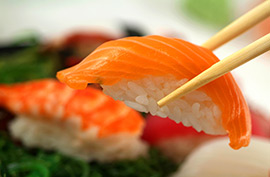 Sit up straight. Use your napkin. Chew with your mouth closed. Don't put your elbows on the table (too much), avoid slurping and burping ... you know your table manners. But those refinements you're so accustomed to may be insignificant or even offensive in other parts of the world.
Sit up straight. Use your napkin. Chew with your mouth closed. Don't put your elbows on the table (too much), avoid slurping and burping ... you know your table manners. But those refinements you're so accustomed to may be insignificant or even offensive in other parts of the world.
In Japan, for example, slurping is actually encouraged. It's considered a compliment to the person who prepared the meal; it shows you like your food.
Which other etiquette pitfalls should you be aware of while traveling? Read on for a few dos and don'ts at tables across the world.
Technically, you can use a fork, but only if you're using it to put food on a spoon. You can't put the fork in your mouth when eating a meal with rice, as it's considered offensive in Thailand; use your spoon instead. If the meal isn't rice-based, a fork might be acceptable, depending on the circumstances. (We recommend observing your fellow diners before digging in.) As for knives, they're off the table -- literally. Thais typically eat with forks and spoons only.
It used to be barbaric to eat food with your fingers in some parts of the world, though some countries have since warmed to the idea. In Chile, however, the old-fashioned rule remains. It's customary to use both a fork and spoon at the table for any type of food, no matter how finger-friendly.
 12 International Foods to Try Before You Die
12 International Foods to Try Before You Die
If you want to live the dolce vita in Italy, don't offend the locals by cross-cutting your spaghetti or any other type of pasta into bite-size pieces. Instead, use your fork to twirl the strands against the side of your bowl. (Spoons should also be avoided.)
In some countries, it's nice to wipe your plate clean -- it shows you truly enjoyed your meal. In China, that's not the case. Leave some food on your plate to show the chef generously provided you so much that you couldn't finish it.
If your glass is half empty, it will be refilled in Egypt -- just not by you. You should never refresh your water or tea yourself; instead, another person at the table is expected to fill your glass, and you should return the favor for him or her.
It's tempting (and delicious) to dip a slice of bread into a bowl of soup, but don't do it while dining in Spain. Sauces are off limits for dipping too. It's considered rude, and you'll get some funny looks.
 How to Save Money on Food When You Travel
How to Save Money on Food When You Travel
 There are numerous taboos when it comes to using your chopsticks in Japan. One of the biggest no-nos is passing food from one set of chopsticks to another; this evokes a Buddhist funeral rite involving the transfer of cremated bones. On a similar note, you shouldn't leave chopsticks upright in your rice bowl -- another practice you'll see at funerals. Finally, never lick food from your chopsticks, and don't cross them when you're not using them. Put them in a holder, if available, or place them parallel to each other on the table.
There are numerous taboos when it comes to using your chopsticks in Japan. One of the biggest no-nos is passing food from one set of chopsticks to another; this evokes a Buddhist funeral rite involving the transfer of cremated bones. On a similar note, you shouldn't leave chopsticks upright in your rice bowl -- another practice you'll see at funerals. Finally, never lick food from your chopsticks, and don't cross them when you're not using them. Put them in a holder, if available, or place them parallel to each other on the table.
 Beyond Restaurants: Eight Ways to Savor a Local Food Scene
Beyond Restaurants: Eight Ways to Savor a Local Food Scene
If there are salt and pepper shakers on the table, by all means help yourself -- just don't request them. In Portugal this is offensive to the chef, who will think you don't like the taste of your food without additional spices.
Respect for one's elders is very important in South Korean culture, and this translates to the country's table manners. Diners generally allow the oldest person at the table to begin eating first as a token of courtesy and appreciation.